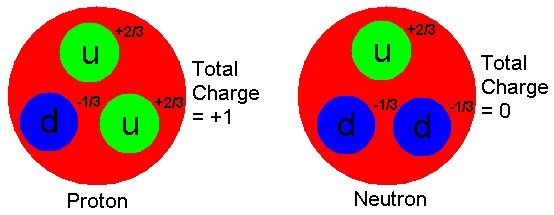Standard Model
There are four types of forces known in the universe. The Standard Model deals with three of them,
the electromagnetic force, weak nuclear force and strong nuclear force because
all attempts to incorporate the gravitational force have failed so far. The Standard Model states that all matter is
essentially constructed from particles with a spin of called fermions. The category of fermions is divided into two
groups: quarks and leptons. Each of these
groups contains 6 flavours or types of either quarks
or leptons.
| |
Quarks: |
|
|
Leptons: |
|
| Up (u) |
Charmed (c) |
Top (t) |
Electron (e) |
Muon
() |
Tauon
(τ) |
| Down (d) |
Strange (s) |
Bottom (b) |
Electron-type neutrino
(υe) |
Muon-type
neutrino (υ) |
Tauon-type
neutrino (υτ) |
Leptons:
Quarks:
Quarks don\92t exist as free particles, and as such can occur
fractionally charged.\A0 As with the leptons
these can be broken up further into two categories of charge.\A0 The quarks with a charge of +2/3 are: up, charmed,
and top.\A0 The quarks charged with a value
of -1/3 are: down, strange, and bottom.\A0 Quarks are found in combinations of quarks.\A0
Protons and neutrons are formed by combinations of three quarks each.\A0
Protons consist of one down and two up quarks resulting in a charge of
+1.\A0 (2/3 + 2/3 \96 1/3 = +1)\A0 Neutrons consist of one up and two down quarks
resulting in a charge of 0.
(2/3 \96 1/3 \96 1/3 = 0)

Interactions
Between Fermions
Fermions exchange particles of integral spin called \93bosons\94
to interact with one another in different types of interactions:
Strong: -binds together
for example the quarks in the neutrons and protons as well as the protons and
neutrons with each other inside nuclei
-mediator is the gluon, a massless particle
Electromagnetic: -binds charged particles,
for example the e- to nuclei
-responsible for the intermolecular forces in liquids and solids
-mediated by the exchange of photons
Weak: -β-decay involving a radioactive
nucleus emitting an electron and neutrino is mediated by the W\B1 and Z0
bosons
It has been thought that these different fields of interaction
are different aspects of a single unified field.\A0 In the 1970\92s it was found that at very high
energies weak and electromagnetic interactions have the same strength, and can
therefore be unified with each other to form the electro-weak force.
CKM Matrix
Quarks can change into another type or \93flavour\94 of quark via weak interaction.\A0 The charge of a quark may only be changed by one unit of elementary charge e.\A0 Because of these circumstances, each of the quarks with a charge of +2/3 (up, charm, top) may change into any quark with a charge difference of e (down, strange, bottom).\A0 We now have 9 different possible transformations that may occur.\A0 When a top quark transforms into a bottom quark we may consider this a \93pairing.\94\A0 Each pairing has its own weak charge attached to it, which is related to a physical constant called the \93coupling constant.\94\A0 We can take these 9 coupling constants and place them in a 3x3 matrix like this:

This is called the Cabbibo-Kobayashi-Maskawa (CKM)
matrix after three Japanese men. The CKM matrix relates the weak eigenstates with the strong eigenstates.\A0 Using this matrix, we can find the probability
of any given quark changing into another.\A0 If we define the probability of an up quark
transforming to a down quark as being Vud2, then all possible
transformations for the up quark can be written as: Vud2
+ Vus2 + Vub2 = 1.\A0 In this framework these values add up to one, however experimental evidence is not that clear.\A0 With experiments in nuclear physics, particularly
at ISAC/TRIUMF which is the one we have access to, with unstable radioactive
nuclei produced online, we mainly look at the up-quark.\A0 Top quarks for example are difficult to produce
and therefore top quark transformations are not observed as often.\A0 The experimental values for the CKM matrix as
of 2002 are:

In fact a 2.2 σ deviation from unity is presently found.
\83t Value
The ft-value represents a transition strength of the weak-or
beta-decay. It consists of an energy dependent Fermi
integral, the f-value, and the half-live of the transition of interest, the
t-value. The ft-value is directly coupled with the CKM matrix element of the
relevant transition. In nuclear physics this corresponds to the Vud elements, where the coupling of an up to a
down quark is described. An experimentally derived ft value should now allow
one to determine the up-down coupling. However, the nuclear environment, in
which the decay occurs, requires the \91simple\92 formulation to be altered by introducing
theoretical correction, namely radiative and Coulomb
corrections.\A0
Theoretical Corrections
We need theoretical corrections when we measure things at a
subatomic level because everything happening outside the system we are trying
to measure affects the system itself.\A0 We
will talk about two different types of theoretical corrections: radiative and Coulomb.
Radiative Corrections:
Radiative corrections are there to
account for the processes allowed by Quantum Electro Dynamics (QED) occurring
in the vacuum and within the nucleus itself.
Coulomb Corrections:
They account for the electroweak interactions affecting the
system we are attempting to measure.\A0 For
example, if we are trying to measure some aspect of the β-decay of a neutron
we may concentrate our measurement on solely the neutron of interest, however
outside that neutron there may be other particles interacting with the neutron.\A0 Coulomb corrections attempt to estimate the
effect of these particles on the neutron of interest but since we cannot accurately
know how these particles interact with each other and the neutron, the Coulomb
corrections can vary.
Author: J. Blaszak
